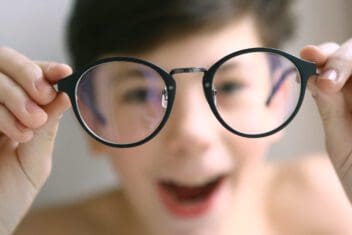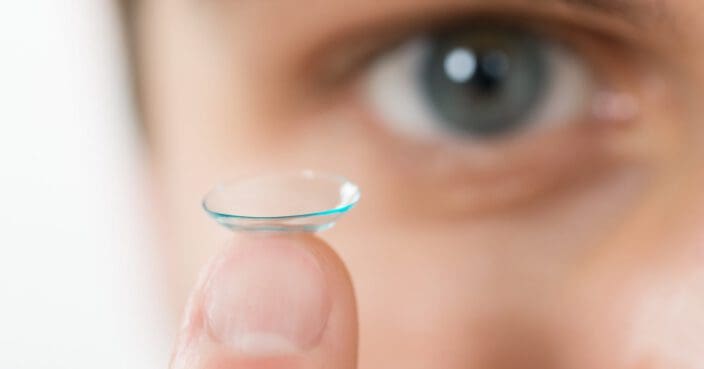Last Updated
Contacts for Kids: Pros and Cons
Home / Children’s Eye Health Guide: Exams, Glasses, & More /
Last Updated
Parents do not always consider contacts an option for children, but they can offer advantages over a traditional pair of glasses. Contacts are safe for children to wear as long as adults make sure they can use them the right way.
Table of Contents
Like patients of any age, there are risks for children who wear contacts. These risks can be mitigated with proper care.
There are cases where glasses are preferable, but contacts are a safe choice and may be better for some children.
Benefits of Contacts for Children

The Centers for Disease Control and Prevention (CDC) say that children can safely wear contacts as long as adults instruct them on how best to wear and care for them. Parents should consider their child’s readiness, maturity, and hygiene when choosing whether or not to get contacts for them.
- Studies show that contact lenses may help to slow the advancement of myopia (nearsightedness) in children compared with the use of glasses.
- It is best to wait until your child is in their teens, so they can responsibly care for their contact lenses and avoid infections. However, one study showed that some children, ages 8 to 11, are responsible enough to take care of their lenses.
- Children are less prone to dry eyes, which often causes problems in adults who wear contacts.
- Contacts may be best for children who are involved in sports. Unlike glasses, which can slip and potentially cause injury, contacts are stable and do not fog up.
Children may be more likely to follow instructions than teens and adults, which reduces the risk of serious infections.
They may also be motivated to use contacts properly because of appearance issues. Often, children feel self-conscious about wearing glasses, and contacts may make them feel better about themselves.
Risks of Contacts for Children
Children, teens, and adults run an equal risk of infection when wearing contacts. Potential risks are:
- Corneal infections, such as keratitis. This affects the clear part of the eye, which covers the colored area.
- Allergic reactions.
- Corneal abrasions, or scratches in the cornea.
- Irritation of the cornea that may indicate an infection.
- Giant papillary conjunctivitis.
- Contact-lens induced acute red eye (CLARE), or red eyes caused by contact lenses.
- These are blood vessels that can cause bloodshot eyes when they develop in the cornea.
Visit your eye doctor if your child presents with certain symptoms, such as:
- Sensitivity to light.
- Abrupt blurry vision.
- Increased eye pain.
- Bloodshot eyes and eye irritation.
- Uncharacteristically watery eyes or increased discharge.

Precautions
There are many steps to follow when wearing contacts. Advise your child to follow these steps:
- Always wash your hands when handling contacts.
- Do not sleep in contacts unless your doctor has prescribed this.
- Use a disinfecting solution for lenses when cleaning your contacts. Do not use saliva or water.
- Change and replace your contact lenses as your doctor instructs.
- Only use the disinfecting solution your doctor recommends.
- Get your eyes checked every year.
- Talk to your doctor about any doubts you have about wearing contacts or how to take care of them.
- Take your contacts out if you experience redness, irritation, watery eyes, or other discomfort.
Always have a pair of glasses with a current prescription in case you need to stop wearing your contacts.
What to Consider When Deciding on Contacts
When you take your child to the doctor, mention their interest in using contacts instead of glasses. Your child’s eye doctor can determine if contacts are a good option for your child. If hygiene is an issue, you can discuss disposable or daily contacts.
Contacts may also be suitable for children who lose or break their glasses frequently and enjoy the outdoors.
To aid your decision, consider this comparison between glasses and contact lenses for children:
| Glasses | Glasses | |
|---|---|---|
| Safety | Less likely to cause eye infections | Proper care required to avoid infections |
| Convenience | Can be inconvenient during physical activities, prone to damage and loss | Convenient for sports, less likely to be damaged |
| Maintenance | Regular cleaning required, but overall lower maintenance | Daily cleaning and proper storage required |
| Vision Correction | Effective for all refractive errors | May not correct all vision problems as effectively as glasses |
| Cost | Typically less expensive over time | Can be more expensive, especially disposables and specialty lenses |
| Appearance/Comfort | Some children may feel self-conscious, but others prefer the look and comfort of glasses | Can boost self-confidence for those who prefer not to wear glasses, but some may find them uncomfortable initially |
How to Choose Contacts for Kids
Selecting the right contact lenses for your child involves multiple considerations. These range from the type of lens suitable for their eye health to the lifestyle factors that could influence lens wear and care. Here are some key points to consider when choosing contacts for your child:
- Type of Lens: There are several types of contact lenses, such as soft, rigid gas permeable (RGP), daily disposable, and extended wear lenses. Soft lenses are commonly used due to their comfort and adaptability. RGP lenses might be a better choice for kids with high astigmatism or those who need sharper vision. Daily disposable lenses can be an excellent option for children due to their convenience and reduced risk of infection. However, it’s essential to consult with an eye care professional to determine which type best fits your child’s needs.
- Child’s Lifestyle and Activities: Consider your child’s daily routine. If they are highly active or participate in sports, contacts are a safer and more convenient option than glasses. If they use digital devices frequently, certain lenses are designed to reduce eye strain associated with digital screen usage.
- Maturity and Hygiene Habits: This is crucial as the handling and care of contact lenses require responsibility. Your child should be capable of cleaning and storing reusable lenses correctly to avoid infections. They should also understand the importance of not sleeping with their contacts in unless the lenses are specifically designed for overnight wear.
- Regular Eye Examinations: If you opt for contact lenses for your child, regular eye check-ups are mandatory. This helps in timely detection of any potential issues, ensuring your child’s eye health is not compromised.
- Selecting the Best Brands: Research or ask your eye care professional about the best brands offering kids’ contact lenses. Some brands may offer products specifically designed for children’s needs, providing more comfort and easier handling.
Remember, while contacts can provide numerous benefits for kids, their safety and comfort should always be the priority. It’s important to involve your child in the process and make sure they are comfortable with the idea of wearing contacts. Ultimately, a discussion with an eye care professional is the best way to make an informed decision about whether contact lenses are right for your child.
Frequently Asked Questions
Are contacts safe for children?
Multiple studies show that can contacts are safe for children to use as long as they follow directions. Most of the time, parents and doctors do not offer contacts to young children, but exceptions can be made for responsible children who can likely practice good hygiene habits.
In some cases, contacts are safer for children. This is true for children who are involved in sports. Glasses may break and injure a child while playing sports.
Are there risks for children who wear contacts?
Anyone who wears contacts may get red, itchy eyes if they do not care for them properly or go to sleep with them in. Corneal injuries, scratches, and conjunctivitis are also common in anyone of any age. Contact lenses should immediately be removed if irritation, redness, and other symptoms of discomfort occur.
When is it better to stick to glasses?
Some children may need to wait longer if they are not yet responsible enough to use contacts. Parents can also wait on contacts if their child is not active in sports.
Children with dry eyes or who are prone to eye infections can wait a little bit longer to consider contact lenses.
Children who wear contacts should carry a pair of glasses with a current prescription in case they need to remove their contacts for any reason.
References
- Children & Contact Lenses. (February 2015) Centers for Disease Control and Prevention.
- Multifocal Contact Lens Effective at Treating Myopia in Kids. (April 2016). American Optometric Association.
- Are Contact Lenses a Good Choice for Kids? (April 2017). All About Vision.
- When Are Kids Old Enough for Contacts? (March 2018). Verywell Health.
- Protect Your Eyes. (August 2019). Centers for Disease Control and Prevention.
- Other Complications. (March 2014). Centers for Disease Control and Prevention.
The information provided on this page should not be used in place of information provided by a doctor or specialist. To learn more, read our Privacy Policy and Editorial Policy pages.